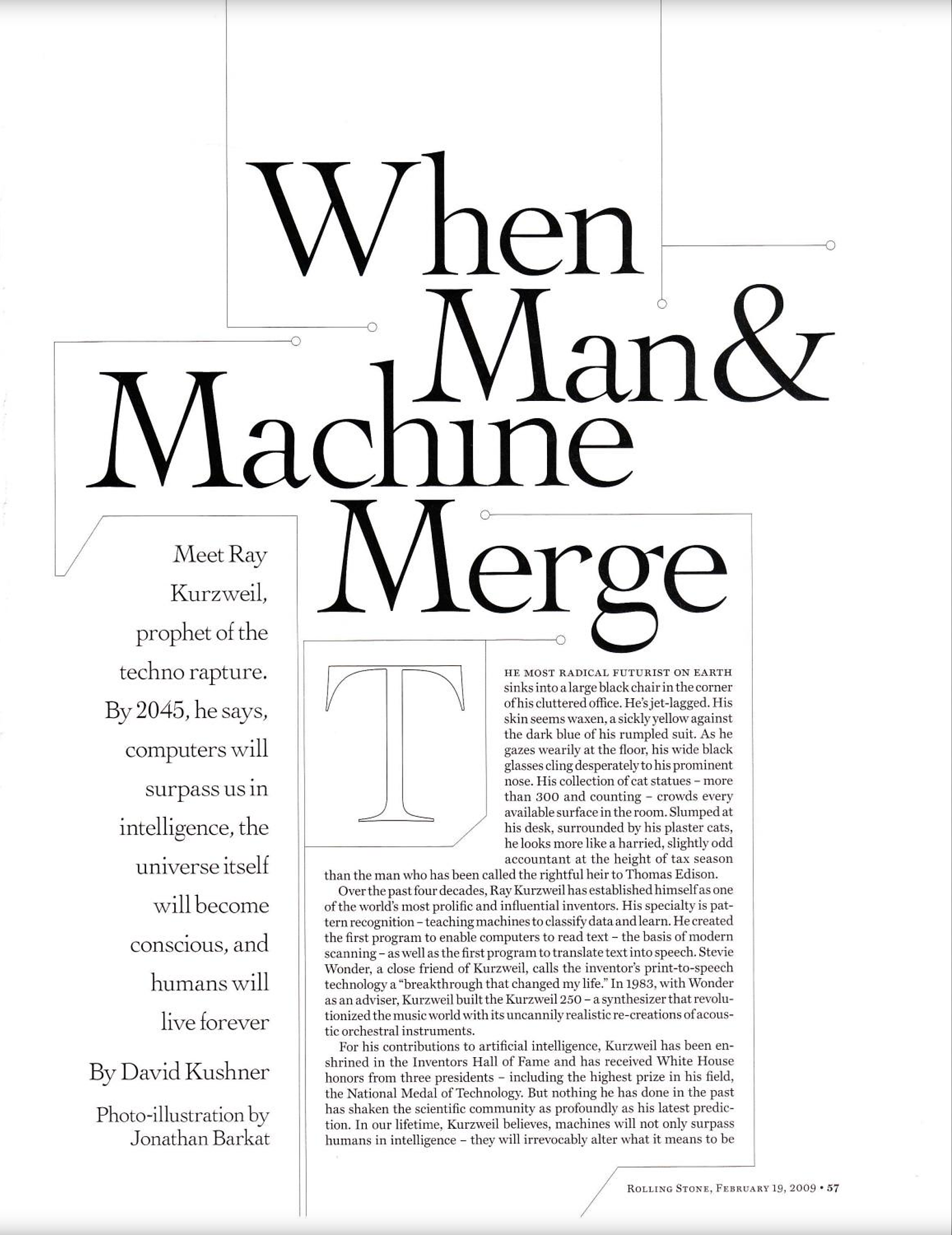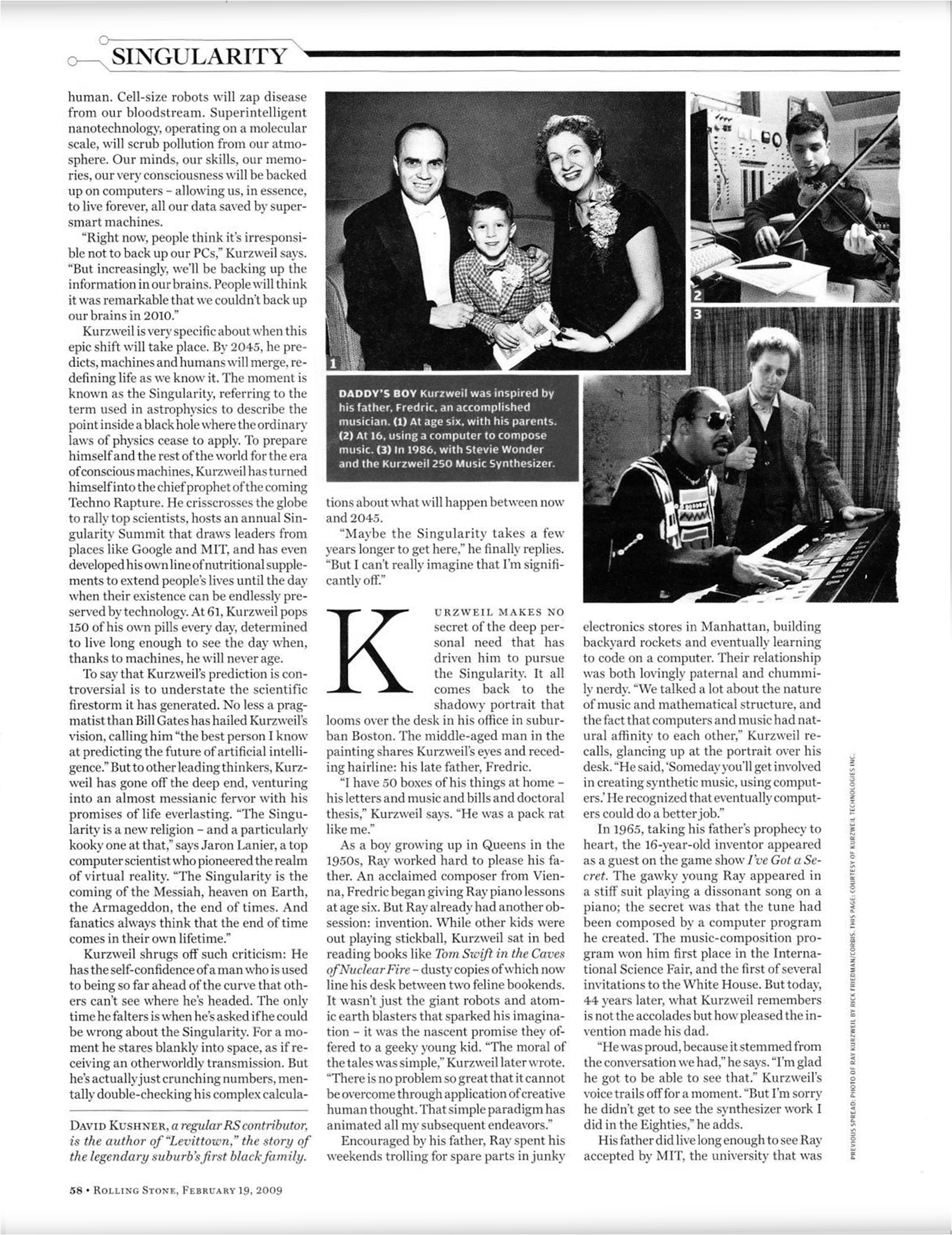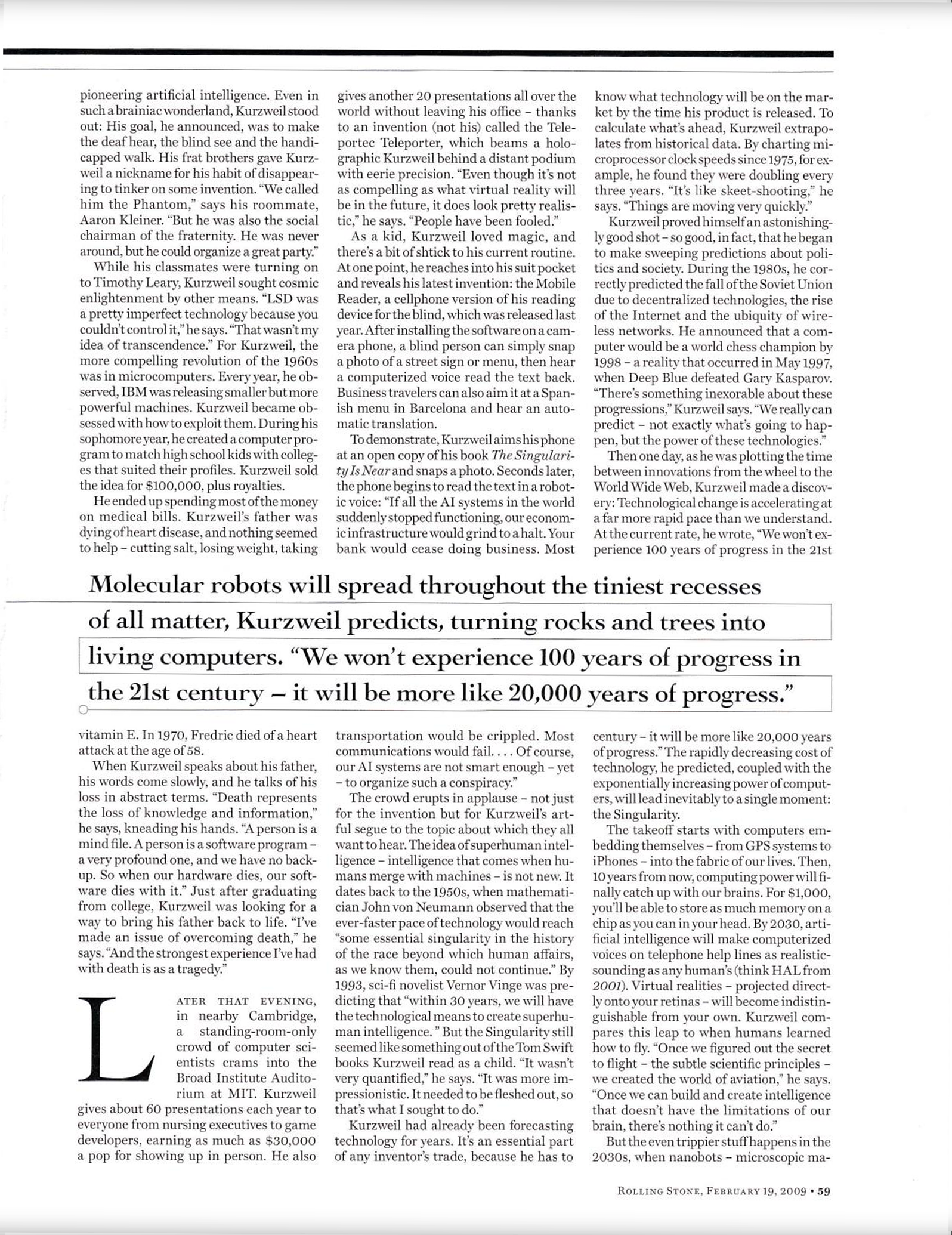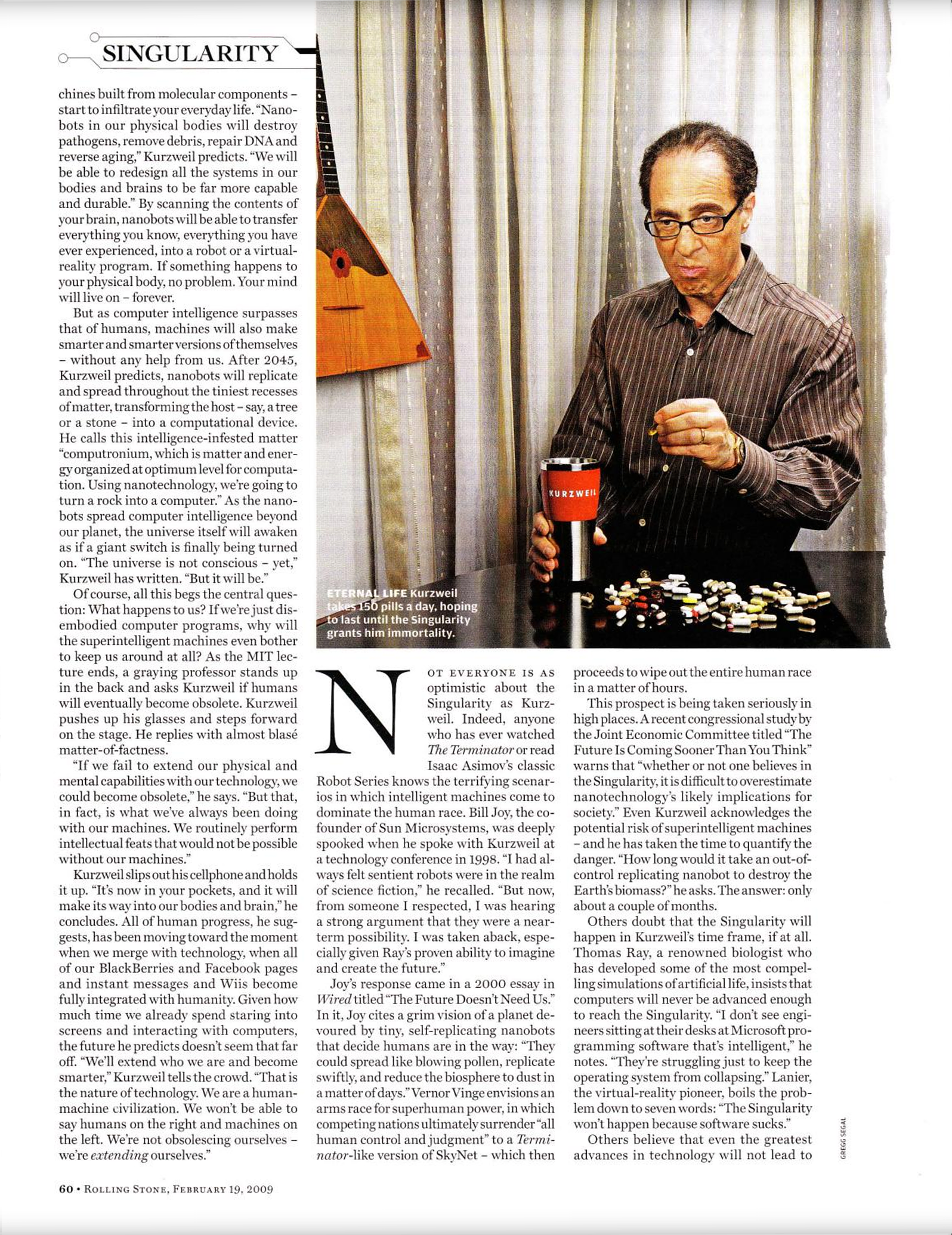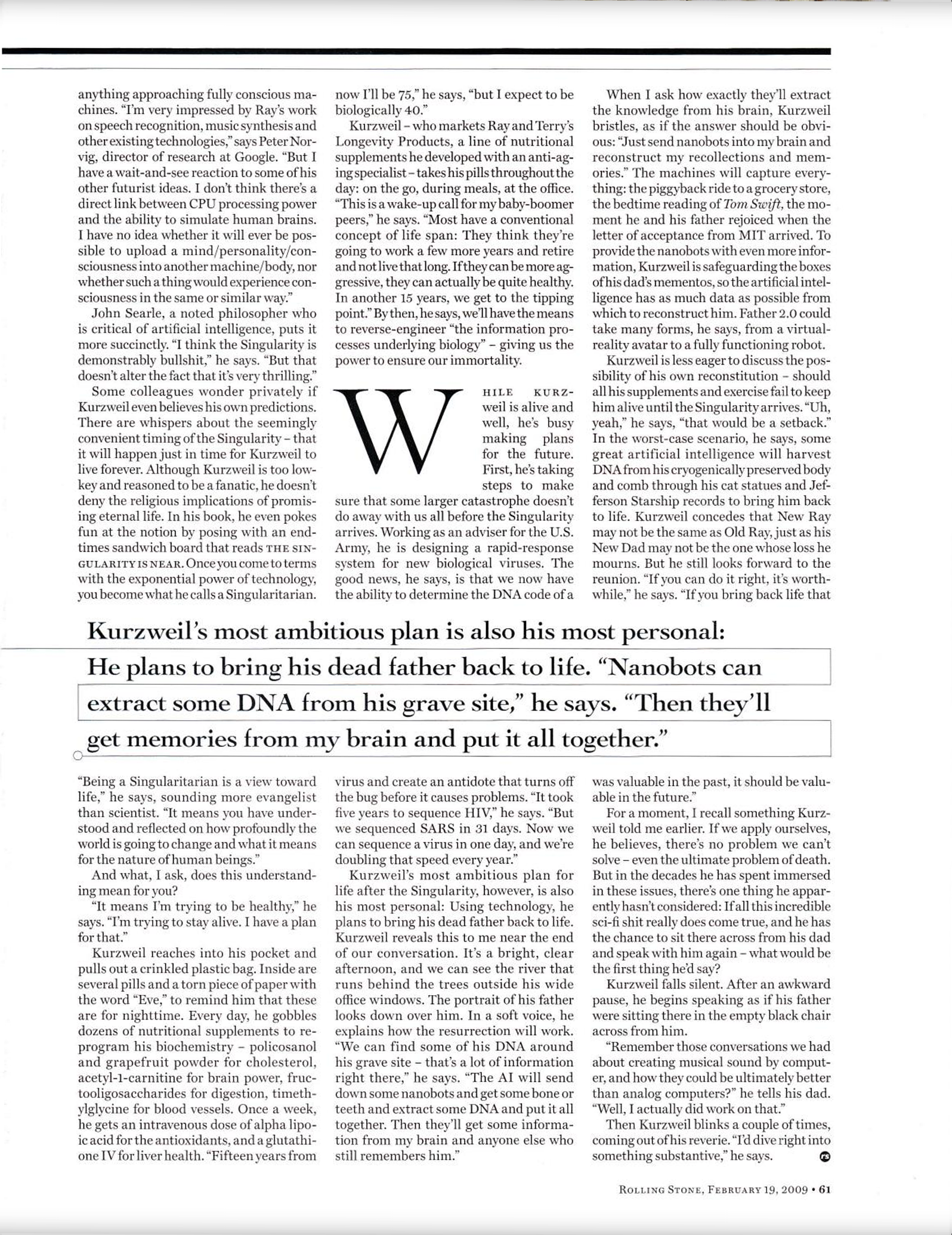feature storyfrom | Rolling Stone2009When man + machine merge.
January 1, 2016


publication: Rolling Stone
issue: no. 1072
cover label: The world’s scariest techno prophet.
story title: When Man + Machine Merge
deck: Ray Kurzweil and the coming tech rapture.
author: by David Kushner
date: February 19, 2009
group: Rock + Roll Hall of Fame
about: 50 year anniversary of the magazine covering music + pop culture.
exhibit: Rolling Stone • 50 Years
video: exhibit tour
design firm: Pentagram co.
album: exhibit photos
Rolling Stone | YouTube channel
Rock + Roll Hall of Fame | YouTube channel

full story | archived w. permission
When Man + Machine Merge: Ray Kurzweil and the coming tech rapture
by David Kushner
— part 1 —
The most radical futurist on earth sinks into a large chair in the corner of his office.
Over the past four decades, Ray Kurzweil has established himself as one of the world’s most prolific and influential inventors. His specialty is pattern recognition — teaching machines to classify data and learn. He created the first program to enable computers to read text — the basis of modern scanning — as well as the first program to translate text into speech.
Stevie Wonder is a close friend of Ray Kurzweil — he calls the inventor’s print-to-speech technology a breakthrough that changed his life. In 1983 with Wonder as an adviser, Kurzweil built the Kurzweil 250: a music synthesizer with its revolutionary, uncanny, realistic re-creations of acoustic orchestral instruments.
For his contributions to artificial intelligence, Kurzweil has been listed in the Inventors Hall of Fame and has received White House honors from 3 US presidents — including the National Medal of Technology. But nothing he has done has shaken the scientific community as profoundly as his latest prediction.
Kurzweil believes that in the near future machines will surpass humans in intelligence –– and alter what it means to be human. Microscopic robots will zap disease from our blood-stream. Super-intelligent nano-technology will scrub pollution from our atmosphere. Our minds, skills, memories will be backed-up on computers — in essence letting us live forever, all our data saved by super-smart machines.
Kurzweil says: “Right now people think it’s irresponsible not to back up our personal computers. But increasingly we’ll be backing up the information in our brains. People will think it was remarkable that we couldn’t back up our brains in 2010.”
Kurzweil is very specific about when the shift will take place. By 2045 he predicts machines and humans will merge, re-defining life as we know it. That time period is known as singularity — it refers to the term from the field of astro physics that describes the point inside a black hole where the ordinary laws of physics cease to apply. To prepare himself and the world for the era of conscious machines, Kurzweil has turned himself into the chief prophet of a future techno rapture. He travels the globe giving speeches to top scientists, and developed his own line of vitamins to extend people’s health. Kurzweil takes 150 supplements daily, determined to live long enough to see the day when he will never age — thanks to progress.
His prediction is controversial. Bill Gates says: “Ray Kurzweil is the best person I know at predicting the future of artificial intelligence.” But to other leading thinkers, Kurzweil has gone off the deep end, venturing into a fervor with promises of life everlasting. Jaron Lanier is a computer scientist who pioneered virtual reality. He said: “Singularity is a kooky new religion. Fanatics always think the end of time comes in their own lifetime.”
Kurzweil shrugs off criticism. He has self-confidence from being so far ahead of the curve that others can’t see where he’s headed. Kurzweil said: “Maybe singularity takes a few years longer to get here. But I can’t imagine I’m significantly off.” He makes no secret of the deep personal need that drives him. A shadowy portrait looms over his desk. The man in the painting has Kurzweil’s eyes: his late father named Fredric Kurzweil. Kurzweil says: “I have 50 boxes of his things at home — his letters and music and bills and doctoral thesis. He was a pack rat like me.”
— part 2 —
As a boy growing up in Queens in the 1950s, Ray worked hard to please his father. A composer from Vienna, Austria — Fredric began giving Ray piano lessons at age 6. While other kids were out playing ball, Kurzweil sat in bed reading the Tom Swift book series. It wasn’t giant robots and atomic earth blasters that sparked his imagination — it was the promise they offered a nerdy young kid. Kurzweil said: “The moral of the stories was simple — there’s no problem so big that it can’t be solved by creative human thought. That simple idea is behind all my projects.”
Encouraged by his father, Ray spent his weekends trolling for spare parts in electronics stores, building back yard rockets and learning to use a computer. Their relationship was paternal and chummy. He said: “We talked about music and math. He said someday you’ll get involved in creating synthetic music using computers. He said eventually computers could do a better job.”
Ray Kurzweil appeared on the television game show I’ve Got a Secret in year 1965. He played a dissonant song on a piano. His secret was that the tune had been composed by a computer program he created. The music composition program was a finalist in the Westinghouse Science Talent Search. He remembers how pleased the invention made his dad.
Kurzweil said: “He was proud because it stemmed from the conversation we had. I’m glad he got to see that. But I’m sorry he didn’t get to see the music synthesizer I helped create in 1980s.” Kurzweil wanted to help the deaf hear, the blind see, and the handicapped walk. His fraternity brothers at the Massachusetts Institute of Technology gave him a nick-name — for disappearing to tinker on some invention. Hi college friend Aaron Kleiner said: “We called him the phantom.”
Kurzweil said the revolution of the 1960s was in micro-computers. Every year IBM was releasing smaller but more powerful machines — he explored how to exploit them. He created a computer program to match high school kids with colleges that suited their profiles. Kurzweil sold the idea for $100,000, plus royalties.
He ended up spending most of the money on medical bills. Kurzweil’s father was dying of heart disease. In 1970 Fredric died of a heart attack at the age of 58.
When Kurzweil speaks about his father, his words come slowly, and he talks of his loss in abstract terms. He said: “Death represents the loss of knowledge and information. A person is a mind file. A person is a software program — a very profound one, and we have no back-up. So when our hardware dies, our software dies with it.” Just after graduating from college, Ray Kurzweil was looking for a way to bring his father back to life. He said: “Overcoming death is my project — the strongest experience I’ve had with death is as a tragedy.”

— part 3 —
When he was a kid he loved magic. At one point in his stage presentation, he reaches into his suit pocket and reveals his latest invention: the Mobile Reader, a smart-phone version of his reading device for the blind.
After installing the software on a mobile phone with a camera: a blind or low vision person can snap a photo of a street sign or menu, then hear a computer voice read the text back, and hear automatic language translation.
Kurzweil reads from his book The Singularity Is Near: “If all artificial intelligence systems in the world suddenly stopped functioning, our economic structure would grind to a halt. Your bank would cease doing business. Most transportation would be crippled. Most communications would fail. Of course our AI systems are not smart enough — yet — to organize such a conspiracy.”
The idea of super-human intelligence — intelligence that comes when humans merge with machines — is not new. It dates back to the 1950s, when mathematician John von Neumann PhD saw the quickening pace of tech would reach: “a singularity in the history of humanity, beyond which human affairs could not continue as we know them.” In year 1993 science fiction author Vernor Vinge PhD predicted: “within 30 years we’ll have the technological means to create super-human intelligence. ”
Kurzweil said he has been forecasting technology for years, he needs to know what technology will be on the market by the time his product is ready. He bases his opinion on historical data. By charting micro-processor speeds since 1975 — he discovered they were doubling every 3 years. He said: “Things are moving very quickly.”
Kurzweil proved his good sense of the future. Now he makes sweeping predictions about politics and society. During the 1980s, he correctly predicted the fall of the Soviet Union due to decentralized technologies, the rise of the internet and wireless networks. He announced that a computer would be a world chess champion by 1998. That happened in May 1997. Kurzweil said: “We really can predict — not exactly what’s going to happen, but the power of technology.”
He was plotting the time between innovations from the wheel to the world wide web when he saw: technological change is accelerating at a far more rapid pace than we understand. He said: “We won’t experience 100 years of progress in the 21st century — it will be more like 20,000 years of progress.” He predicts: rapidly decreasing cost of technology, along with exponentially increasing power of computers, will lead to singularity.”
It starts with computers embedded in the fabric of our lives — from GPS to smart-phones. 10 years from now, computing power will finally catch up with human thinking abilities. For $1,000 you’ll be able to store as much memory on a chip as your body does. By 2030 artificial intelligence will make computerized voices on telephones sound and interact like a human. Then virtual reality and augmented reality — in eyewear — will become life-like. Kurzweil compares this leap to when humans learned how to fly with aircraft. He said: “Once we figured out the secret to flight — the subtle science — we created the world of aviation. Once we can build intelligence that doesn’t have the limits of our bodies and minds — there’s nothing it can’t do.”
He predicts in the 2030s: nanobots — microscopic machines built from tiny components — will infiltrate your everyday life. He said: “Nanobots in our physical bodies will destroy pathogens, remove debris, modify DNA and reverse aging. We will upgrade all the systems in our bodies to be more capable and durable.” Kurzweil believes that by scanning the contents of your brain, nanobots will be able to transfer everything you know, everything you’ve experienced — into a robot or a virtual reality program.
But as computer intelligence surpasses human intelligence, machines will also make smarter versions of themselves — without any help from us. Kurzweil predicts after year 2045: nanobots will replicate and spread into the tiniest recesses of matter, transforming the host — for example a tree or a stone — into a computational device. He calls this intelligence infested matter called computronium — a concept of matter and energy organized at optimum level for computation. He said: “Using nanotechnology we’re going to turn a rock into a computer. As the nanobots spread computer intelligence beyond our planet, the universe will awaken as if a giant switch is turned on. The universe is not conscious but it will be.”
— part 4 —
What will happen to us? If we’re just dis-embodied computer programs, why will the super-intelligent machines keep us around? Will humans eventually become obsolete. Kurzweil said: “If we fail to extend our physical and mental capabilities with our technology, we could become obsolete. But that’s what we’ve always been doing with our machines. We routinely do intellectual feats not be possible without our machines.”
Kurzweil slips out his mobile phone and holds it up. He said: “It’s now in your pockets — and will make its way into our bodies and brain. All of human progress has been moving toward a merger with our tech. Given how much time we now spend on digital device screens and interacting with computers, Kurzweil’s vision of the future doesn’t seem far off. He said: “We’ll extend who we are and become smarter. We’re a human machine civilization. We won’t be able to say humans on the right and machines on the left. We’re not becoming obsolete — we’re extending ourselves.”
Not all people are as optimistic about singularity as Ray Kurzweil. Anyone who has watched the movie The Terminator or read science fiction author Isaac Asimov’s novels about robots — knows the terrifying plot scenario when intelligent machines come to the human race. Author and computer scientist Bill Joy — a co-founder of Sun Microsystems co. — spoke with Ray Kurzweil in year 1998. Bill Joy said: “I thought sentient robots were science fiction. But I was hearing strong arguments they were a near possibility. I was surprised, because of Ray Kurzweil’s ability to see and imagine the future.”
Bill Joy wrote an essay in Wired magazine in the year 2000 called: “The Future Doesn’t Need Us.” Joy imagines a grim vision of a planet devoured by tiny, self-replicating nanobots that decide humans are in the way. Joy says: “They spread like blowing pollen, replicate and reduce the bio-sphere to dust in days.”
Author and scientist Vernor Vinge sees a race for super-human power — nations ultimately surrender all control and judgment to an artificial intelligence that wipse out the entire human race in a matter of hours.
This prospect is being taken seriously in high places. A recent congressional study by the Joint Economic Committee titled “The Future Is Coming Sooner Than You Think” warns that “whether or not one believes in the Singularity, it is difficult to overestimate nanotechnology’s likely implications for society.” Even Kurzweil acknowledges the potential risk of superintelligent machines – and he has taken the time to quantify the danger. “How long would it take an out-of-control replicating nanobot to destroy the Earth’s biomass?” he asks. The answer: only about a couple of months.
Others doubt that the Singularity will happen in Kurzweil’s time frame, if at all. Thomas Ray, a renowned biologist who has developed some of the most compelling simulations of artificial life, insists that computers will never be advanced enough to reach the Singularity. “I don’t see engineers sitting at their desks at Microsoft programming software that’s intelligent,” he notes. “They’re struggling just to keep the operating system from collapsing.” Lanier, the virtual-reality pioneer, boils the problem down to seven words: “The Singularity won’t happen because software sucks.”
Others believe that even the greatest advances in technology will not lead to anything approaching fully conscious machines. “I’m very impressed by Ray’s work on speech recognition, music synthesis and other existing technologies,” says Peter Norvig, director of research at Google. “But I have a wait-and-see reaction to some of his other futurist ideas. I don’t think there’s a direct link between CPU processing power and the ability to simulate human brains. I have no idea whether it will ever be possible to upload a mind/personality/consciousness into another machine/body, nor whether such a thing would experience consciousness in the same or similar way.”
John Searle, a noted philosopher who is critical of artificial intelligence, puts it more succinctly. “I think the Singularity is demonstrably bullshit,” he says. “But that doesn’t alter the fact that it’s very thrilling.”
Some colleagues wonder privately if Kurzweil even believes his own predictions. There are whispers about the seemingly convenient timing of the Singularity – that it will happen just in time for Kurzweil to live forever. Although Kurzweil is too low-key and reasoned to be a fanatic, he doesn’t deny the religious implications of promising eternal life. In his book, he even pokes fun at the notion by posing with an end-times sandwich board that reads the singularity is near. Once you come to terms with the exponential power of technology, you become what he calls a Singularitarian. “Being a Singularitarian is a view toward life,” he says, sounding more evangelist than scientist. “It means you have understood and reflected on how profoundly the world is going to change and what it means for the nature of human beings.”
— part 5 —
And what, I ask, does this understanding mean for you? Kurzweil says: “It means I’m trying to be healthy. I’m trying to stay alive. I have a plan for that.”
Kurzweil reaches into his pocket and pulls out a crinkled plastic bag. Inside are several pills and a torn piece of paper with the word “Eve,” to remind him that these are for nighttime. Every day, he gobbles dozens of nutritional supplements to reprogram his biochemistry – policosanol and grapefruit powder for cholesterol, acetyl-1-carnitine for brain power, fructooligosaccharides for digestion, timethylglycine for blood vessels. Once a week, he gets an intravenous dose of alpha lipoic acid for the antioxidants, and a glutathione IV for liver health. “Fifteen years from now I’ll be 75,” he says, “but I expect to be biologically 40.”
Kurzweil – who markets Ray and Terry’s Longevity Products, a line of nutritional supplements he developed with an anti-aging specialist- takes his pills throughout the day: on the go, during meals, at the office. “This is a wake-up call for my baby-boomer peers,” he says. “Most have a conventional concept of life span: They think they’re going to work a few more years and retire and not live that long. If they can be more aggressive, they can actually be quite healthy. In another 15 years, we get to the tipping point.” By then, he says, we’ll have the means to reverse-engineer “the information processes underlying biology” – giving us the power to ensure our immortality.
WHILE Kurzweil is alive and well, he’s busy making plans for the future. First, he’s taking steps to make sure that some larger catastrophe doesn’t do away with us all before the Singularity arrives. Working as an adviser for the U.S. Army, he is designing a rapid-response system for new biological viruses. The good news, he says, is that we now have the ability to determine the DNA code of a virus and create an antidote that turns off the bug before it causes problems. “It took five years to sequence HIV,” he says. “But we sequenced SARS in 31 days. Now we can sequence a virus in one day, and we’re doubling that speed every year.”
Kurzweil’s most ambitious plan for life after the Singularity, however, is also his most personal: Using technology, he plans to bring his dead father back to life. Kurzweil reveals this to me near the end of our conversation. It’s a bright, clear afternoon, and we can see the river that runs behind the trees outside his wide office windows. The portrait of his father looks down over him. In a soft voice, he explains how the resurrection will work. “We can find some of his DNA around his grave site – that’s a lot of information right there,” he says. “The AI will send down some nanobots and get some bone or teeth and extract some DNA and put it all together. Then they’ll get some information from my brain and anyone else who still remembers him.”
When I ask how exactly they’ll extract the knowledge from his brain, Kurzweil bristles, as if the answer should be obvious: “Just send nanobots into my brain and reconstruct my recollections and memories.” The machines will capture everything: the piggyback ride to a grocery store, the bedtime reading of Tom Swift, tr»e moment he and his father rejoiced when the letter of acceptance from MIT arrived. To provide the nanobots with even more information, Kurzweil is safeguarding the boxes of his dad’s mementos, so the artificial intelligence has as much data as possible from which to reconstruct him. Father 2.0 could take many forms, he says, from a virtual reality avatar to a fully functioning robot.
Kurzweil is less eager to discuss the possibility of his own reconstitution – should all his supplements and exercise fail to keep him alive until the Singularity arrives. “Uh, yeah,” he says, “that would be a setback.” In the worst-case scenario, he says, some great artificial intelligence will harvest DNA from his cryogenically preserved body and comb through his cat statues and Jefferson Starship records to bring him back to life. Kurzweil concedes that New Ray may not be the same as Old Ray, just as his New Dad may not be the one whose loss he mourns. But he still looks forward to the reunion, “If you can do it right, it’s worthwhile,” he says, “If you bring back life that was valuable in the past, it should be valuable in the future.”
For a moment, I recall something Kurzweil told me earlier. If we apply ourselves, he believes, there’s no problem we can’t solve – even the ultimate problem of death. But in the decades he has spent immersed in these issues, there’s one thing he apparently hasn’t considered: If all this incredible sci-fi shit really does come true, and he has the chance to sit there across from his dad and speak with him again – what would be the first thing he’d say?
Kurzweil falls silent. After an awkward pause, he begins speaking as if his father were sitting there in the empty black chair across from him.
“Remember those conversations we had about creating musical sound by computer, and how they could be ultimately better than analog computers?” he tells his dad. “Well, I actually did work on that. I’d dive right into something substantive,” he says.
— end of story —
print | magazine
Full story from Rolling Stone.
— page no. 1 —
— page no. 2 —
— page no. 3 —
— page no. 4 —
— page no. 5 —
